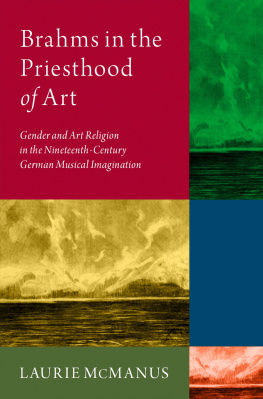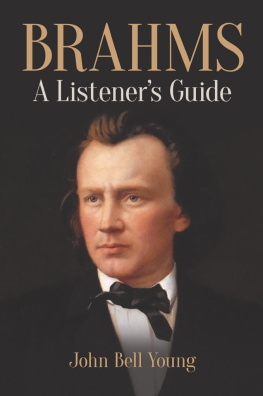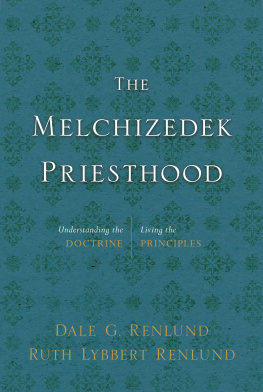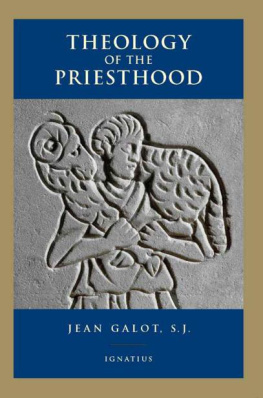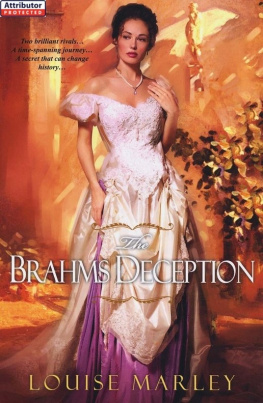Laurie McManus - Brahms in the Priesthood of Art
Here you can read online Laurie McManus - Brahms in the Priesthood of Art full text of the book (entire story) in english for free. Download pdf and epub, get meaning, cover and reviews about this ebook. year: 2020, publisher: OxfordUP, genre: Romance novel. Description of the work, (preface) as well as reviews are available. Best literature library LitArk.com created for fans of good reading and offers a wide selection of genres:
Romance novel
Science fiction
Adventure
Detective
Science
History
Home and family
Prose
Art
Politics
Computer
Non-fiction
Religion
Business
Children
Humor
Choose a favorite category and find really read worthwhile books. Enjoy immersion in the world of imagination, feel the emotions of the characters or learn something new for yourself, make an fascinating discovery.
- Book:Brahms in the Priesthood of Art
- Author:
- Publisher:OxfordUP
- Genre:
- Year:2020
- Rating:4 / 5
- Favourites:Add to favourites
- Your mark:
- 80
- 1
- 2
- 3
- 4
- 5
Brahms in the Priesthood of Art: summary, description and annotation
We offer to read an annotation, description, summary or preface (depends on what the author of the book "Brahms in the Priesthood of Art" wrote himself). If you haven't found the necessary information about the book — write in the comments, we will try to find it.
Brahms in the Priesthood of Art — read online for free the complete book (whole text) full work
Below is the text of the book, divided by pages. System saving the place of the last page read, allows you to conveniently read the book "Brahms in the Priesthood of Art" online for free, without having to search again every time where you left off. Put a bookmark, and you can go to the page where you finished reading at any time.
Font size:
Interval:
Bookmark:


Oxford University Press is a department of the University of Oxford. It furthers the Universitys objective of excellence in research, scholarship, and education by publishing worldwide. Oxford is a registered trade mark of Oxford University Press in the UK and certain other countries.
Published in the United States of America by Oxford University Press
198 Madison Avenue, New York, NY 10016, United States of America.
Oxford University Press 2021
All rights reserved. No part of this publication may be reproduced, stored in a retrieval system, or transmitted, in any form or by any means, without the prior permission in writing of Oxford University Press, or as expressly permitted by law, by license, or under terms agreed with the appropriate reproduction rights organization. Inquiries concerning reproduction outside the scope of the above should be sent to the Rights Department, Oxford University Press, at the address above.
You must not circulate this work in any other form and you must impose this same condition on any acquirer.
Library of Congress Cataloging-in-Publication Data
Names: McManus, Laurie, author.
Title: Brahms in the priesthood of art : gender and art religion in the
nineteenth-century German musical imagination / Laurie McManus.
Description: New York : Oxford University Press, 2021. |
Includes bibliographical references and index.
Identifiers: LCCN 2020023553 (print) | LCCN 2020023554 (ebook) |
ISBN 9780190083274 (hardback) | ISBN 9780190083304 (online) |
ISBN 9780190083281 (updf) | ISBN 9780190083298 (epub)
Subjects: LCSH: Brahms, Johannes, 18331897Criticism and interpretation.
| Brahms, Johannes, 18331897AppreciationHistory. |
Music18th centuryHistory and criticism. | MusicReligious aspectsHistory.
Classification: LCC ML410.B8 M32 2021 (print) |
LCC ML410.B8 (ebook) | DDC 780.92dc23
LC record available at https://lccn.loc.gov/2020023553
LC ebook record available at https://lccn.loc.gov/2020023554
This book has been many years in the making, with input and assistance from many people. First, I would like to thank Suzanne Ryan for her foresight and guidance in bringing the project to fruition. Naturally, my work has benefitted from the numerous conversations with friends and scholars in the area, including Karen Leistra-Jones, Ben Korstvedt, Alex Stefaniak, Katharina Uhde, Kevin Karnes, Dan Beller-McKenna, Marcia Citron, and Kira Thurman, all of whom have also provided moral support during the long process. Others who have read parts of the manuscript and deserve thanks for their time and valuable feedback include Margaret Notley, David Brodbeck, Natasha Loges, John Reef, Matthew Franke, Alanna Ropchock Tierno, and Patrick Domico.
My writing groups, with friends in the field and beyond, have proved invaluable to working out ideas and staying on track. I would also like to thank those friends not aforementioned who have provided encouragement, humor, and sounding boards for ideas: Catherine Hughes, Doug Shadle, Travis Stimeling, Oren Vinogradov, Aimee Slaughter, Mitch Ohriner, and Paul Sommerfeld. I also could not have completed this project without the help from archivists at the Gesellschaft fr Musikfreunde in Vienna, the Staatsbibliothek zu Berlin, and the Bayerische Staatsbibliothek. A final note of thanks is due to John Romano for the music engravings.
I have explored aspects of this project in previous publications. Some of
In a study of rhetoric, it is necessary to read sources in the original German; however, I have also consulted English translations where available. In each case where I have cited or modified an existing English translation, both German and English versions are cited in the footnote. Otherwise, translations are my own with the input from Katharina Uhde, to whom I am grateful for her advice and insight.
I spared myself no trouble and work to awaken and nurture it [Brahmss talent] in order to raise a priest of art, who would preach afresh, in a new way the sublime, true, and everlasting eternality of art and achieve it in the deed itself.
Eduard Marxsen, 1874
To all appearances, however, this [Brahms] was a very respectable phenomenon; only it remains doubtful how such a phenomenon could be set up in a natural way as the Messiah, or, at least, the Messiahs most beloved disciple; unless, indeed, an affected enthusiasm for medieval wood-carvings should have induced us to accept those stiff wooden figures for the ideals of ecclesiastical sanctity.
Richard
Brahmss early composition teacher, Eduard Marxsen, and his outspoken antipode, Richard Wagner, together offer us a sense of the competing rhetorics of art religion (Kunstreligion) in the latter half of the nineteenth century. They both drew on an older, Romantic notion of the exceptional artist as a quasi-religious figure who was set apart from society by the destiny of great talent and an almost monastic devotion to his or her art. Underpinning this notion was the fundamental belief in musics power to transport the listener to spiritual realms, to the extent that engagement with art might replace confessional religious practice. The occluded nature of this musical discourse created an opportunity for exceptional composers and performers to mediate between the divine and the mundane. Thus, neither Marxsen nor Wagner seemed interested in disputing the art-religious ideology itself, but rather differed in its application to Brahms. They also each had something at stake in Brahmss reception: At nearly seventy, Marxsen looked to Brahms as a lasting legacy of his teaching; Wagner, still at work on his magnum opus Ring cycle, stood to benefit from disparaging the younger composer who in the late 1860s had just achieved national fame with his German Requiem.
As Marxsens and Wagners comments suggest, by the 1870s Brahms and some performers in his circle had garnered the title of priests of music, and even beyond their individual profiles, they collectively formed what influential critic Eduard Hanslick deemed a priesthood of art. This exceptional group included the violinist Joseph Joachim, pianist Clara Schumann (ne Wieck), and singers Amalie Joachim (ne Schneewei) and Julius Stockhausen. Brahms was the unique character among them in that he identified first and foremost as a composer, and his compositions garnered more value than his performances as a pianist. The very juxtaposition on concert programs of Brahms with Beethoven, Schubert, and Bach helped to induct Brahms into the hallowed realm of serious composers. In particular, Brahms supporters consistently spoke of his musical purity, a term heavily laden with long-standing moral and ethical associations, which would figure in a larger cultural conflict against Richard Wagner. Marxsens comments indicate the great extent to which some of these supporters depicted Brahms as a quasi-religious hero, while Wagners demonstrate how the priestly persona could be lampooned as an exaggerated invention of fawning admirers, or worse, a pretentious cover for personal deficiencies.
Why study the rhetoric of artistic priesthood in Brahmss time? Broadly speaking, the perseverance of an art-religious ethos into the period after the failed social revolutions of 1848 and 1849 demonstrates the continued currency of musics supposed mystical power even in the face of technological and scientific progress. Music maintained its ability to transport listeners to safe realms, offer spiritual refuge, and promote moral uplift. Particularly in the circle around Brahms and Clara Schumann, music offered a means of emotional disclosure and interpersonal communication.project an air of aloofness to the general public, reinforcing the image of an artist devoted humbly to their art. Through the turns and gestures of public discourse, the meanings of private musical utterances were translated into art-religious rhetoric that invited interpretation on levels beyond the circles where they originated.
Font size:
Interval:
Bookmark:
Similar books «Brahms in the Priesthood of Art»
Look at similar books to Brahms in the Priesthood of Art. We have selected literature similar in name and meaning in the hope of providing readers with more options to find new, interesting, not yet read works.
Discussion, reviews of the book Brahms in the Priesthood of Art and just readers' own opinions. Leave your comments, write what you think about the work, its meaning or the main characters. Specify what exactly you liked and what you didn't like, and why you think so.

